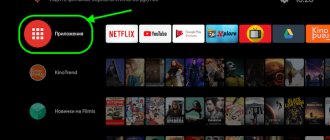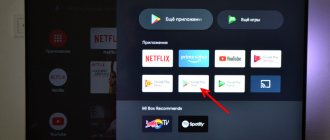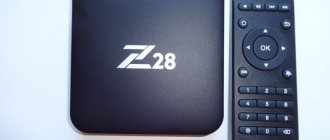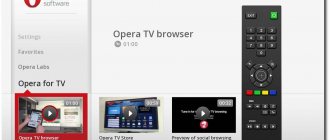Mi Box with Android TV 6 - international version of Android box from Xiaomi
Recently I told you about Xiaomi Mi Box 3 Enhanced, a powerful Android box that is designed for the Chinese market. But today it’s my turn to talk about the Xiaomi Mi Box with the international version of Android TV 6. I also bought it as a New Year’s gift (and it has already settled in a new family). But giving it away without writing a detailed review would be a sin... I ordered it from the popular MOBASE store on Aliexpres for $74.99, because... At the time of ordering, based on reviews on various forums, only they had the box in real stock (now many already have it).
Xiaomi stated that Mi Box was created in partnership with Google. At a minimum, Google is involved in its promotion. The operating system is the stock Android TV 6 from Google.
There are only three boxes with Android TV on the Google website, and one of them is Mi Box.
At the time of writing the review, Mi Box was officially sold on the American market, but it can also be purchased in Chinese online stores without any problems. The very appearance of boxing on sale was a surprise to many. News about the collaboration between Xiaomi and Google on a TV box has been circulating since spring 2021. And at the end of September, without any announcement, Mi Box appeared on the shelves of all Walmart stores, causing a heated discussion of this event on the Internet. In early October, Xiaomi made an official announcement, putting all the dots in place.
Content
- Range of Xiaomi boxes
- Specifications
- Equipment and appearance
- Android TV 6
- Performance in synthetic tests
- Internal and external storage
- Network interface speed
- General information about the audio and video decoding system
- Sound format support and audio output
- Video format support and video output
- IPTV and Torrent TV
- YouTube 1080p60
- HDMI CEC
- Conclusion
Range of Xiaomi boxes
Before I start a detailed story about Mi Box, I’ll briefly talk about the range of Android boxes from Xiaomi, because...
the confusion in the names misleads some people. Xiaomi Mi Box mini / 小米盒子mini版 / MDZ-15-AA
The smallest Android box from Xiaomi. Made on the basis of SoC MT8685 from MediaTek (4 Cortex-A7 cores with a frequency of up to 1.3 GHz, Mali-450 GPU). 1 GB RAM and 4 GB ROM. Supports Wi-Fi 802.11a/b/g/n 2.4/5 GHz (MIMO 1x1) and Bluetooth 4.0. The operating system based on Android 4.4.2 is entirely in Chinese and with Chinese services (no Google services). The only interfaces are HDMI 1.4. Remote control with Bluetooth support. This box is intended for the Chinese market only.
Xiaomi Mi Box 3c / 小米盒子3c / MDZ-16-AA
Made on the basis of SoC AMLogic S905-H (4 Cortex-A53 cores with a frequency of up to 2 GHz, Mali-450 GPU). 1 GB RAM and 4 GB ROM. Supports Wi-Fi 802.11a/b/g/n/ac 2.4/5 GHz (MIMO 1x1) and Bluetooth 4.1. The operating system based on Android 5.0 is entirely in Chinese and with Chinese services (Google services are not available). Interfaces: HDMI 2.0, USB 2.0, analog audio output, Mini Toslink optical audio output (combined with analog). Remote control with Bluetooth support and microphone. This box is intended for the Chinese market only.
Xiaomi Mi Box 3s / 小米盒子3s / MDZ-19-AA
Made on the basis of SoC AMLogic S905X-H (4 Cortex-A53 cores with a frequency of up to 2 GHz, Mali-450 GPU). 2 GB RAM and 8 GB ROM. Supports Wi-Fi 802.11a/b/g/n/ac 2.4/5 GHz (MIMO 1x1) and Bluetooth 4.1. The operating system based on Android 6.0 is entirely in Chinese and with Chinese services (no Google services). Interfaces: HDMI 2.0a, USB 2.0, analog audio output, Mini Toslink optical audio output (combined with analog). Remote control with MiTouch touch ring (not Bluetooth, IR). This box is intended for the Chinese market only.
Xiaomi Mi Box 3 Enhanced / 小米盒子3 增强版 / MDZ-18-AA
The most powerful box from Xiaomi and one of the most powerful on the market. Made on the basis of SoC MT8693 from Mediatek (2 Cortex-A72 cores + 4 Cortex-A53 2 GHz cores, PowerVR GX6250 GPU). 2 GB RAM and 8 GB ROM. Supports Wi-Fi 802.11a/b/g/n/ac 2.4/5 GHz (MIMO 2×2) and Bluetooth 4.1. The operating system based on Android 5.1 is entirely in Chinese and with Chinese services (no Google services). Interfaces: HDMI 2.0, 2 x USB 2.0. Remote control with Bluetooth support, microphone, large number of sensors (accelerometer, gyroscope, etc.). This box is intended for the Chinese market only. This console already has an official international name - Xiaomi Mi Box Pro, but the international version has not yet been officially announced.
Xiaomi Mi Box / MDZ-16-AB
Essentially this is Xiaomi Mi Box 3s (MDZ-19-AA). Only the operating system is a pure Android TV 6 system with Google services, a complete remote control without a MiTouch touch ring, but works via the Bluetooth interface and has a built-in microphone. This is the console we will talk about today.
Specifications
__table_placeholder1__Sometimes the question is raised online about how the AMLogic S905X-H differs from the S905X. The letter H means that the SoC already has licenses for decoding DD 5.1 and DTS, and the manufacturer of the final product does not need to pay for them additionally.
Equipment and appearance
Mi Box comes in a cardboard box.
Technical data is printed on the back of the box.
Inside: set-top box, power supply, remote control, HDMI cable, brief instructions in English.
The attachment is very compact, 101x101x20.5 mm, but heavy - 178 g, because There is a large metal plate installed inside for cooling. Housing made of black matte plastic.
There is a rubberized insert on the bottom.
There is a small window on the front, behind which a white LED is hidden. It shines softly and does not catch the eye. Behind the same window is an undocumented IR receiver. The set-top box can be controlled not only by a Bluetooth remote control, but also by an IR remote control with a corresponding known set of codes (this has been confirmed by several owners).
At the rear there are: DC power connector, USB 2.0 port, HDMI 2.0a port, mini-jack audio output combined with optical Mini Toslink.
If you already have a cable with Toslink connectors, then just buy a small Mini Toslink adapter for 30 cents.
The Android TV control panel operates via the Bluetooth interface. Buttons: Power, D-pad with central action button, Back, Home screen, microphone activation, volume control.
The remote control is powered by two AAA batteries. There is no strap included, but the remote control itself has a strap holder. The remote control has a built-in microphone. Unlike Xiaomi Mi Box Pro, the remote control does not have any sensors (accelerometer, gyroscope, etc.).
The original kit includes a Xiaomi power supply with an American-Chinese plug. The seller replaced the power supply with a version with a European plug. Power supply characteristics: 5.2 V / 2.1 A. Cord length is about 1 meter. DC connector 4 x 1.7 mm.
The included HDMI cable is about 90 cm long.
It is difficult to disassemble the attachment without damaging it. I will provide photographs of the disassembled box from the Internet. A massive iron plate is installed inside, which cools the SoC, memory chips and Wi-Fi/Bluetooth controller through thermal substrates. The Wi-Fi controller itself is implemented on a Broadcom BCM4345 chip.
Android TV 6
The “pure” Android TV 6 system is the best thing about this set-top box. The system is in Russian (there are some untranslated elements in the settings), voice search is supported in Russian, which works just fine. Google's Android TV Launcher is used as a launcher.
Global search works great.
You can watch the weather, search for videos on YouTube, etc. For example, if you search for a movie, then in the search results you can see its description and actors. You can go straight to Google Play Movies. If you have another program for online video installed that is fully integrated into Android TV (for example, ATV Videobox), then in the search results you can immediately go to this program if the movie is there. The children figured out the console themselves in a couple of minutes; they liked the quick voice search for cartoons.
In the Home Screen settings, you can enable recommendations from different programs (even third-party ones, if they support this feature). For example, on the main screen there may be recommendations for videos from YouTube or films and TV series from ATV Videobox and other installed programs.
The Google Play Store here is different from the app store on the regular Android system. Here are only those programs whose interface is adapted for control from the remote control, including games that can be played using the remote control. There are also games that can be played using a gamepad. You can install them if your gamepad is connected to the console.
Playing with a remote control is no more difficult than playing on a smartphone.
The entire range of Google Play Store can be explored in about 10 minutes. Many popular programs (for example, MX Player, Kodi, VLC, ES Explorer, ivi, etc.) are already here. But every day there will be more programs adapted for Android TV.
You can install an Android TV remote control on your smartphone - this is a program from Google. All controls are there and you can enter text using your smartphone keyboard.
If you wish, you can always install regular Android programs. You can install them through a browser on your computer (just select installation on a console on the Google Play website) or simply using an apk file. You can even use a browser (for example, Chrome) on the console itself. But to fully work with such programs, you will need, at a minimum, to connect a mouse or remote control with mouse emulation. My devices (Logitech K400r keyboard with touchpad and Rii mini i25 remote with gyroscopic mouse and keyboard) worked without problems. In Android TV settings, you cannot select additional layouts for hardware keyboards. I used the External Keyboard Helper Pro program, in it you can select layouts for any languages and a keyboard shortcut to switch between layouts.
The system interface and animation work quickly and smoothly, there is no discomfort.
Of course Google Cast works. You can, for example, open a video on YouTube on your smartphone and start playing it in Mi Box with one click. You can control playback from your smartphone. If necessary, you can close YouTube on your smartphone, but playback on Mi Box will not be interrupted. The same applies to music and, in general, to any programs that support Google Cast.
Interacting with Android TV 6 and programs is a pleasure - very simple and effective.
Performance in synthetic tests
The set-top box uses SoC AMLogic S905X. This SoC is not characterized by high performance; its main purpose is media content. 4 Cortex-A53 cores with a frequency of up to 2 GHz, Mali-450 GPU.
I performed all tests with a resolution of 1920x1080.
If you use 4K resolution, gaming performance will drop catastrophically. AnTuTu v6.2.6 Overall index: 35591 3D: 2783
GFXBench T-Rex: 9.9 fps T-Rex offscreen: 10 fps
Bonsai Overall index: 1753 Average frames per second: 25 fps
3DMark Ice Storm Extreme: 3917
Geekbench 4 Single-Core: 630 Multi-Core: 1737
Google Octane Total index: 3519
Without load, the temperature of the outer body of the box is about 33 °C. With load it reaches 40 °C. No overheating or throttling was noticed.
Internal and external storage
Xiaomi Mi Box has only 8 GB of internal memory. Of this, about 4 GB is available for installing games and programs. When you connect a USB flash drive, you can set programs to be installed on this drive. But when selecting this menu, the system gives an error. There are similar reviews from other owners. You need to wait for a system update to fix it.
Internal memory speed test in A1 SD Bench:
The set-top box supports FAT32, exFAT, NTFS file systems on external media.
Network interface speed
The Xiaomi Mi Box has a Wi-Fi controller from Broadcom BCM4345 with support for the 802.11a/b/g/n/ac, 2.4/5 GHz, MIMO 1×1 standard.
The set-top box is located 5 meters from the router through one reinforced concrete wall. At this point, most of my 802.11n (MIMO 1x1) devices show speeds up to 50/50 Mbps. Laptop with MIMO 2x2 around 80/80 Mbps. Smartphones with MIMO 2×2 are also around 80/80 Mbit/s. A stationary computer with MIMO 3x3 at 5 GHz here (if placed nearby) squeezes out about 100/100 Mbit/s. All this is the real data transfer speed (measured by iperf), and not the connection speed. Of the latest devices tested: Xiaomi Mi Box 3 Enhanced - 150 Mbit/s, Morefine M1s stick - 95 Mbit/s.
The sensitivity of the Xiaomi Mi Box is quite high; the set-top box has seen many Wi-Fi networks. We connect to the 5 GHz network. Internet speed 80/108 Mbit/s .
The actual data transfer speed within a local network using iperf is
111 Mbit/s .
The speed is at a very high level.
It was not possible to beat the record holder Xiaomi Mi Box 3 Enhanced, but the result is excellent compared to other devices. But the speed of work via the Samba protocol was a little disappointing. Without buffering, MX Player only pulled streams up to 40 Mbps.
You can connect a USB 3.0 Gigabit Ethernet adapter to the set-top box via USB (directly or via a hub). In this case, the speed will be slightly higher than 200 Mbit/s. Adapters that are made on ASIX controllers are supported (confirmed by the owners). I have a USB 3.0 Gigabit Ethernet adapter on Realtek, but it didn't work, i.e. There are no drivers for Realtek in the system - this needs to be taken into account.
General information about the audio and video decoding system
Android has two libraries for system (hardware) decoding of video and audio content: Stagefright and MediaCodec.
For example, the popular player MX Player uses Stagefright in HW mode, and MediaCodec in HW+. Kodi uses MediaCodec by default. In Xiaomi Mi Box there is a complete mess going on with decoders in different libraries. Some decoders are supported in one library but not in another. For example, looking ahead, system audio decoders only work with Stagefright, and 4K HEVC Main 10 decoding only works with MediaCodec. But these are all little things that can be resolved by setting up and choosing a video player. But I would like to pay attention to the rendering when using Stagefright (HW). If you look closely when playing some video files, in HW mode the rendering quality is significantly lower than HW+. This is the first time I've encountered something like this. Here are two still frames (I took it with a camera, because in HW mode screenshots do not capture video).
I can only give one small recommendation - use MX Player with an additional set of software audio codecs in HW+ or Kodi / SPMC mode.
Sound format support and audio output
The set-top box can output sound via HDMI, optical output, and analog output.
For the test I will use four MKV files with tracks: Dolby Digital 5.1, DTS 5.1, Dolby TrueHD 7.1, DTS-HD MA 7.1. As players I will use MX Player (without installing additional codecs, only system decoders) and Kodi (it uses software decoders). I can’t check the Pass-Through output for Dolby TrueHD 7.1, DTS-HD MA 7.1, because... my equipment does not support these formats, but other owners confirm that HD audio output is not supported in RAW format. First, let's check the local audio decoding:__table_placeholder2__Audio output via HDMI and optical (Pass-Through):__table_placeholder3__
Video format support and video output
The set-top box has an HDMI 2.0a output and supports image output with a resolution of 3840× [email protected] Hz (10 bits per channel) and HDR, if the TV has the appropriate support. I cannot check support for 4K and HDR mode. But real owners on various forums confirm that there are no problems with this resolution and HDR. I will test on TV in 1920× [email protected] Hz mode.
You can download all video files from the test using the link.
The set-top box does not have “autoframe” support, i.e. The scan frequency does not switch during video playback.
Using the Judder_test_24p.mp4 file, we check for the presence of a judder effect (unevenness). We start the video and take a picture of the screen with a shutter speed of 1 second.
Judder effect is present. The set-top box does a standard 3:2 pulldown conversion for 24p > 60p conversion, frames are displayed for a different amount of time.
Enable the HDMI self-adaptation function in the settings. And we take a photo.
As you can see, now the system does not do a 3:2 pulldown, but for each frame changes the display time on the screen, based on some internal algorithm. This is not motion interpolation (I double-checked that no additional frames are generated), but the visual judder effect is much less noticeable. So it's better to enable HDMI self-adaptation.
Using the 1080p60.mp4 file, we check the fairness of the 60p output (so that there is no duplication of frames). We start the video and take a picture of the screen with a shutter speed of 1 second.
Fair and uniform 60 frames per second without duplicates.
Using the file jellyfish-55-mbps-hd-h264.mkv we will check support for the H.264 codec. This file has a bitrate of 55 Mbps and a resolution of 1920x1080. The maximum video bitrate on Blu-ray is 48 Mbps. If the test file is played without drops and freezes, then the set-top box will easily play absolutely any BD Remux (and any BDRip). The file plays perfectly. There are no complaints about the H.264 decoder. The video was decoded without any problems using the Stagefright (HW) and MediaCodec (HW+) libraries.
Using the file jellyfish-140-mbps-4k-uhd-hevc-10bit.mkv, we will check support for the HEVC/H.265 Main10 codec. This file has a bitrate of 140 Mbps and a resolution of 3840x2160. The maximum video bitrate on Ultra HD Blu-ray is 128 Mbps. If the test file is played without drops and freezes, then the set-top box will easily play absolutely any UHD BD Remux (and any UHD BDRip). The file can only be played using the MediaCodec (HW+) library. The video plays, but frame drops are visually visible. As the bitrate decreases, there are fewer drops, and they disappear completely only with a flow of about 70 Mbit/s. Xiaomi Mi Box cannot cope with perfect playback of UHD BD Remux and UHD BDRip. 4K decoding support only applies to online content (which typically does not have a high bitrate) up to 70 Mbps.
Another bug has been discovered. If 4K HEVC Main10 is played back, then at lower resolution 1080p the HEVC Main10 decoder does not work correctly. This bug is confirmed by other owners.
Using the 1080p_Hi10P.mkv file, we will check whether the SoC is powerful enough to play H.264 Hi10p video (this is H.264 10 bit) - the format is non-standardized, hardware decoders are rare. In program mode without drops, this file cannot be played. Using the MediaCodec (HW+) library, the hardware decoder is turned on, the video is played, but there are too many visual artifacts.
In general, we can say that the Xiaomi Mi Box plays video well, but 4K content with a high bitrate is not for it.
IPTV and Torrent TV
IP television from a provider with IPTV + MX Player or Kodi, pirated television OTT CLUB (the program of which is also optimized for Android TV), Torrent Stream Controller (Torrent TV) + MX Player - all this worked flawlessly.
When working with IPTV, one significant bug was discovered in the operation of system decoders.
In fact, I already read about it in thematic forum threads, but now I personally confirmed it. In Xiaomi Mi Box at the time of writing the review, deinterlacing in video did not work! This is a childhood disease (for example, the first Nvidia Shield firmware also suffered from it), and I can’t even imagine how this could have been missed before the product was released. Deinterlacing only refers to interlaced video, not progressive, but these are the types of streams that are often found in IPTV. In HW mode (Stagefright library), deinterlacing did not work correctly, creating unpleasant flickering in some parts of the image. In HW+ mode (MediaCodec library), only one field was displayed (the second was simply discarded), which reduced the actual video resolution. For example, here is a piece of video with a resolution of 576i, on the left is HW+ (one field is discarded), on the right is the correct operation of deinterlacing:
YouTube 1080p60
The YouTube client, which is also adapted for Android TV, supports 1080p60 on this box.
But one unpleasant bug surfaced when playing 1080p60 YouTube. At some point (most often this happens after sleep modes), 1080p60 videos on YouTube begin to briefly jam every 5 seconds. Only rebooting the console helps. At the same time, 1080p50, 1080p30, etc. are played normally. The problem is confirmed by many owners on various forums. Those. Again, you need to wait for a system update to fix this bug.
HDMI CEC
Of course, HDMI CEC operation floats from TV to TV. But in my case with two LG TVs, HDMI CEC support was very limited in this device (or completely absent). The set-top box can only go into sleep mode when the TV is turned off. The TV remote control does not work.
Conclusion
Overall, I really liked the Xiaomi Mi Box. High-quality manufacturing, convenient remote control, fast Wi-Fi, convenience of stock Android TV 6, excellent voice search, Google Cast support. But the presence of bugs slightly spoils the overall impression of the console. Let me remind you of the main ones: the deinterlacing system does not work (critical for those who watch IPTV), DTS output (Pass-Through) does not work, assigning a USB drive as main memory does not work (you cannot install many games), periodic problems with 1080p60 content on YouTube. I would like to believe that the bugs will be fixed during the next system update, but there are famous companies behind the box - Xiaomi and Google.
Equipment
Along with the Xiaomi Mi Box 3 console, the box contains:
- A remote control designed to control TV settings and games.
- Adapter with Euro plug 1 m long
- HDMI cable with short (90 cm) wire
The remote control has a microphone and works via Bluetooth, so there is no need to constantly keep the set-top box in sight. There is voice search in Russian. The function works without errors.
There are few buttons on the remote control:
- Navigation with 5 positions,
- “Home”, “Back”, “Menu”
- Inclusion
- Power supply 5V/2.1A
The body is made of black plastic. There is a place to attach a strap, although there are no straps themselves. There are also no additional sensors. AA batteries (not included) are inserted into regular connectors inside the case.
Applications
The fact that the Xiaomi model is international means the ability to access all Google services. After connecting the set-top box and connecting it to the Internet, you can go to the store and select any of the applications provided there. On Google Play, choose paid or free games.
Users indicate that owners of the reduced version do not have access to some of the full applications. Only those programs that can be controlled using the remote control are installed there. There are also those that require a gamepad to use. It is purchased separately and connected to the console.
You can install other programs and applications through a PC browser or an archived APK file. But in this case, you need to connect a mouse to control the device. You cannot select an additional keyboard layout in the Android TV settings. You can install the Android TV remote control program on your smartphone.
The model supports 4k video. All declared formats can be launched easily. The image quality is high.
Design
The console has a simple appearance - a streamlined and smooth square body, the corners are very smooth, there is thinning closer to the side edges, the highest height is in the center, a couple of centimeters.
There is a rubberized ring on the bottom edge, which significantly reduces the device’s slipping on smooth surfaces. It also ensures stability even when connecting any cables and massive media.
Thanks to its small size, the set-top box can be placed under any TV.
The body of the console is completely plastic, the surface is matte, and is produced in only one color – black. Although fingerprints remain on it, they are very easy to remove. On the front side there is an infrared receiver with a device operation indicator; connectors for connecting external devices are located on the rear side - a full-size USB port, a mini-Jack that combines digital optical and analog audio outputs, as well as an HDMI output.
There are no buttons on the case. Neither the workmanship nor the assembly of the case raise any complaints - this is a compact, durable and stylish-looking box made in a minimalist design.
Key Features
4K video at 60 frames per second
To provide the user with maximum comfort while watching video content, the company’s specialists have developed a set-top box that is capable of reproducing content in the highest resolution without any freezes - up to 4K at a frequency of up to 60 frames per second.
Powerful electronic filling
Thanks to the high technical parameters, the device is capable of not only reproducing the highest quality media content, but also responding with lightning speed to any tasks set by the user. There is support for interaction with other devices - HDMI 2.0b, USB and AV interfaces are provided for this.
You can connect external devices via Bluetooth and using ports on the set-top box
High-quality sound, communication and control
The sound capabilities of the device are striking in their quality: it supports a combined Dolby Digital Plus and DTS 2.0 audio system, which provides realistic surround sound, complementing the ideal picture when viewing content.
As for wireless interfaces, Mi Box 3 has Wi-Fi 802.11ac and Bluetooth version 4.1. A separate nice feature is the remote control with a voice control button, the use of which greatly facilitates the work with the TV set-top box when controlling and searching for content.
"Artificial Intelligence" PatchWall
Support for the PatchWall system is exactly what provides the set-top box with smart functions. It analyzes user actions related to video content and selected objects, based on this, it offers the user its own version of the content that matches his preferences.
Network and information formats
Xiaomi Mi 3 supports IPTV technology and can work in Internet browser mode. Chromecast technology allows you to play any video from your phone or computer on your TV. Wireless interfaces installed:
- Bluetooth1 +EDR is implemented on the Broadcom BCM4345 chip. There are complaints that sometimes it disconnects on its own and the connection to the Internet disappears. This happens after being unplugged, while the connection level for other devices remains normal. It connects easily, just press and hold two keys on the remote control.
- Wi-Fi 11a/b/g/n/ac, operates in 2.4 and 5 GHz frequencies, MIMO 1x1
- USB 2.0 Type A
Software
The shell of the Xiaomi Mi TV Box EU version is “pure” Android TV 6 with minimal changes from the manufacturer - there is only a separate section with installed applications, including:
TV Xiaomi Mi TV 4C 50
- Netflix;
- Red Bull TV;
- Google Play Market;
- YouTube;
- Google Movies;
- Google Music;
- Google Games.
Otherwise, everything is usual - announcements of the most popular films, a list of installed software, full access to Google services, since this is still an international model. There is access to voice search - this important element of the Android TV OS is fully accessible - the microphone is built right into the remote control. Using it, you can search for content in all applications. Russian speech recognition is quite good, so the voice assistant can be used as the main control method, using text only in some cases.
The console menu has standard Google services
Features of working with the console
When the set-top box is turned on for the first time, it prompts the user to quickly configure it using an Android-based mobile device.
In this case, the Google application is launched on the smartphone, “set up my device” is entered in the search, after which Mi Box will be found, which must be on the same network. In addition, you can set up the media player in the standard way - connect to your home wireless network and log in to Google or Mi Box using your smartphone by going to the g.co/AndroidTV page, where you enter the PIN code displayed on the TV screen with a set-top box.
You can play content via Mi Box either directly from the network or from a connected storage device. You will first need to install the video player from the app store.
Note! The company's software store will display only programs optimized for consoles, so the list will be much shorter than on a tablet or smartphone.
There is another option for installing applications - using apk files that are written to a connected disk or flash drive, having first allowed the installation of software from unverified sources. It must be remembered that if you install software that is not optimized for Android TV, you may need to connect a mouse or a gyroscopic remote control.
Approximately 5 GB of storage that can be used is usually not enough for full work with a smart set-top box, but the situation can be easily corrected by connecting a USB drive if applications are installed on it, a flash drive or disk is formatted - and the speed of work from the media is practically negligible differs from using the software that is installed on the internal drive.
The international version of Xiaomi Mi Box has Google Cast support, thanks to which you can stream audio and video content to your TV from your smartphone; for this, Google Home is installed on it, after which you can broadcast video, audio, view photos on the big screen, and so on.
When playing video, the player copes well with a bitrate of 160 Mbit/s, which is enough even for 4K; even the largest files are launched in a maximum of a couple of seconds.
You can play 3D games on the console











